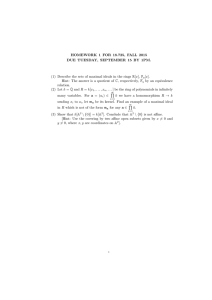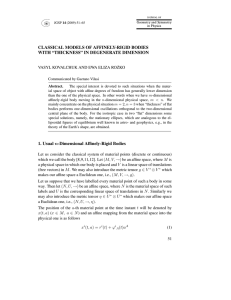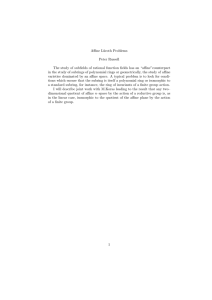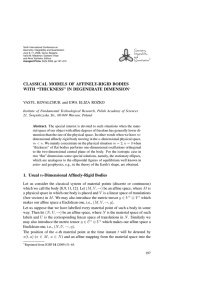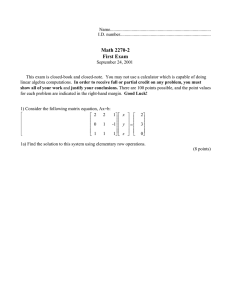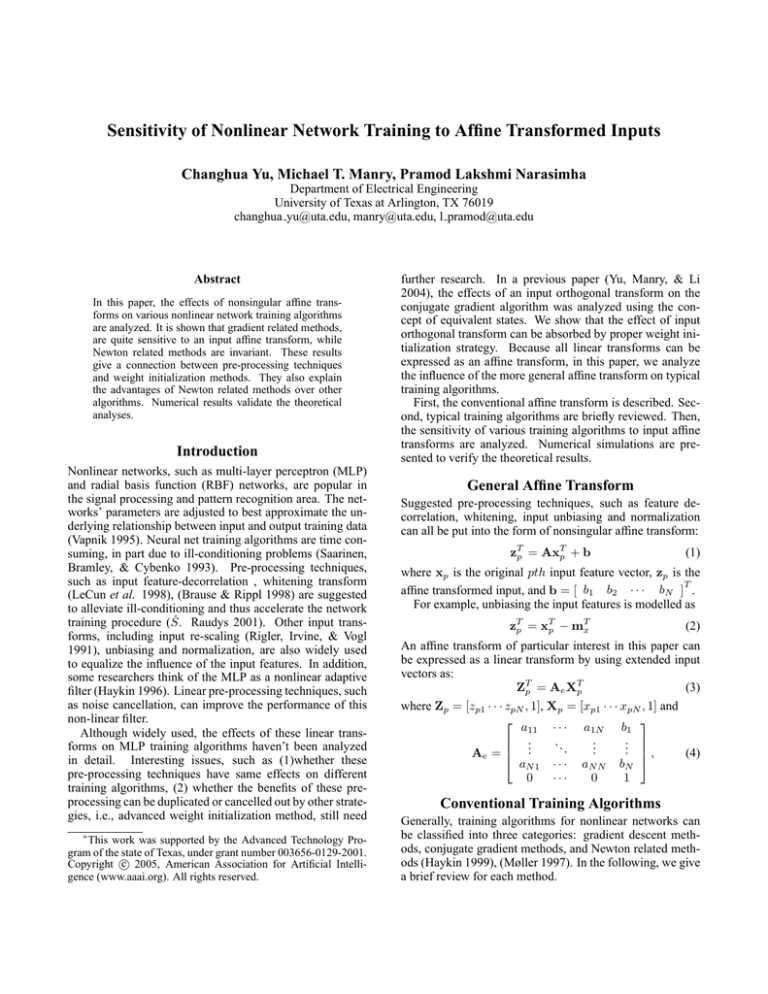
Sensitivity of Nonlinear Network Training to Affine Transformed Inputs
Changhua Yu, Michael T. Manry, Pramod Lakshmi Narasimha
Department of Electrical Engineering
University of Texas at Arlington, TX 76019
changhua yu@uta.edu, manry@uta.edu, l pramod@uta.edu
Abstract
In this paper, the effects of nonsingular affine transforms on various nonlinear network training algorithms
are analyzed. It is shown that gradient related methods,
are quite sensitive to an input affine transform, while
Newton related methods are invariant. These results
give a connection between pre-processing techniques
and weight initialization methods. They also explain
the advantages of Newton related methods over other
algorithms. Numerical results validate the theoretical
analyses.
Introduction
Nonlinear networks, such as multi-layer perceptron (MLP)
and radial basis function (RBF) networks, are popular in
the signal processing and pattern recognition area. The networks’ parameters are adjusted to best approximate the underlying relationship between input and output training data
(Vapnik 1995). Neural net training algorithms are time consuming, in part due to ill-conditioning problems (Saarinen,
Bramley, & Cybenko 1993). Pre-processing techniques,
such as input feature-decorrelation , whitening transform
(LeCun et al. 1998), (Brause & Rippl 1998) are suggested
to alleviate ill-conditioning and thus accelerate the network
training procedure (Š. Raudys 2001). Other input transforms, including input re-scaling (Rigler, Irvine, & Vogl
1991), unbiasing and normalization, are also widely used
to equalize the influence of the input features. In addition,
some researchers think of the MLP as a nonlinear adaptive
filter (Haykin 1996). Linear pre-processing techniques, such
as noise cancellation, can improve the performance of this
non-linear filter.
Although widely used, the effects of these linear transforms on MLP training algorithms haven’t been analyzed
in detail. Interesting issues, such as (1)whether these
pre-processing techniques have same effects on different
training algorithms, (2) whether the benefits of these preprocessing can be duplicated or cancelled out by other strategies, i.e., advanced weight initialization method, still need
∗
This work was supported by the Advanced Technology Program of the state of Texas, under grant number 003656-0129-2001.
c 2005, American Association for Artificial IntelliCopyright °
gence (www.aaai.org). All rights reserved.
further research. In a previous paper (Yu, Manry, & Li
2004), the effects of an input orthogonal transform on the
conjugate gradient algorithm was analyzed using the concept of equivalent states. We show that the effect of input
orthogonal transform can be absorbed by proper weight initialization strategy. Because all linear transforms can be
expressed as an affine transform, in this paper, we analyze
the influence of the more general affine transform on typical
training algorithms.
First, the conventional affine transform is described. Second, typical training algorithms are briefly reviewed. Then,
the sensitivity of various training algorithms to input affine
transforms are analyzed. Numerical simulations are presented to verify the theoretical results.
General Affine Transform
Suggested pre-processing techniques, such as feature decorrelation, whitening, input unbiasing and normalization
can all be put into the form of nonsingular affine transform:
zTp = AxTp + b
(1)
where xp is the original pth input feature vector, zp is the
T
affine transformed input, and b = [ b1 b2 · · · bN ] .
For example, unbiasing the input features is modelled as
zTp = xTp − mTx
(2)
An affine transform of particular interest in this paper can
be expressed as a linear transform by using extended input
vectors as:
(3)
ZTp = Ae XTp
where Zp = [zp1 · · · zpN , 1], Xp = [xp1 · · · xpN , 1] and
a11 · · · a1N b1
..
..
..
..
.
.
. ,
.
Ae =
(4)
a
· · · aN N bN
N1
0
···
0
1
Conventional Training Algorithms
Generally, training algorithms for nonlinear networks can
be classified into three categories: gradient descent methods, conjugate gradient methods, and Newton related methods (Haykin 1999), (Møller 1997). In the following, we give
a brief review for each method.
where the learning factor Z is usually set to a small
positive constant or determined by an adaptive or optimal method(Magoulas, Vrahatis, & Androulakis 1999).
The back propagation (BP) algorithm is actually a gradient descent method (Haykin 1999), (Rumelhart, Hiton, &
Williams 1986). When using an optimal learning factor, the
gradient descent method is also known as steepest descent
(Fletcher 1987).
Conjugate Gradient Method
Figure 1: Topology of a three-layer MLP
Notation
In this paper, we investigate a three-layer fully connected
MLP, as shown in figure 1. The training data consists of Nv
training patterns {(xp , tp )}, where xp and the pth desired
output vector tp have dimensions N and M , respectively.
Thresholds in the hidden and output layers are handled by
letting xp,(N +1) = 1.
For the jth hidden unit, the net function netpj and the
output activation Opj for the pth training pattern are
netpj =
N
+1
X
whi (j, n) · xpn
n=1
Opj = f (netpj )
(5)
1 ≤ j ≤ Nh
where xpn denotes the nth element of xp , whi (j, n) denotes
the weight connecting the nth input to the jth hidden unit
and Nh denotes the number of hidden units. The activation
function f is sigmoidal
1
1 + e−netpj
for the pth training pattern is
f (netpj ) =
The kth output ypk
ypk =
N
+1
X
woi (k, n) · xpn +
n=1
Nh
X
woh (k, j) · Opj
(6)
Newton’s Method
(7)
j=1
k = 1, . . . , M , where woi (k, n) denotes the weight connecting the nth input node to the kth output unit. The network’s
training procedure is to minimize the following global Mean
Square Error (MSE):
Nv
Nv X
M
1 X
1 X
(tp −yp )(tp −yp )T
[tpm −ypm ]2 =
Nv p=1
Nv p=1 m=1
(8)
where tpm denotes the mth element of tp . Many methods
have been proposed to solve this optimization problem.
E=
Gradient Descent Method
The idea of gradient descent method is to minimize the linear approximation of MSE in (8):
∂E
= E(w) + ∆wT g (9)
∂w
where g is the gradient vector of E(w) evaluated at current
w. The weight updating strategy is:
E(w + ∆w) ≈ E(w) + ∆wT
∆w = −Z · g
People have looked for some compromise between slow
converging gradient methods and computationally expensive
Newton’s methods (Møller 1997). Conjugate gradient (CG)
is such an intermediate method.
The basic idea of CG is to search the minimum of the
error function in conjugate directions (Fletcher 1987). In
CG, the directions P(i) for the ith searching iteration and
P(j) for the jth iteration have to be conjugate with respect
to the Hessian matrix:
for i 6= j
(11)
PT (i)HP(j) = 0
The conjugate directions can be constructed by (Fletcher
1987):
(12)
P(k) = −g(k) + B1 P(k − 1)
Here, g(k) represents the gradient of E with respect to corresponding weight and threshold for the kth searching iteration. Initial vectors are g(0) = 0, P(0) = 0. B1 in Eq. (12)
is the ratio of the gradient energies between the current iteration and the previous iteration. The corresponding weight
changes in CG are:
(13)
∆w = B2 · P(k)
where B2 is an optimal learning factor.
(10)
The goal in Newton’s method is to minimize the quadratic
approximation of the error function E(w) around the current
weights w:
1
E(w + ∆w) ≈ E(w) + ∆wT g + ∆wT H∆w (14)
2
Here, the matrix H is called the Hessian matrix, which is
the second order partial derivatives of E with respect to w.
Eq. (14) is minimized when
∆w = −H−1 g
(15)
For Newton’s method to work, the Hessian matrix H has to
be positive definite, which is not guaranteed in most situations. Many modified Newton algorithms have been developed to ensure a positive definite Hessian matrix (Battiti
1992).
Sensitivity of Training to Affine Transform
For affine transforms, the requirements to ensure equivalent
states (Yu, Manry, & Li 2004) in the network with original
inputs and the network with transformed inputs are:
(16)
whi = uhi Ae
woh = uoh , woi = uoi Ae
(17)
where u denote the corresponding weights and thresholds in
the transformed network.
Sensitivity of CG to Affine Transform
Affine Transforms and OWO-BP
In CG, for the kth training iteration, the weight updating law
in the transformed network is:
In output weight optimization (OWO), which is a component of several training algorithms (Chen, Manry, & Chandrasekaran 1999), we solve linear equations for MLP output
weights. In the following, we will use Wo = [woi woh ]
and an augmented input vector:
uhi ← uhi + B2 · Pdhi (k),
uoh ← uoh + B2 · Pdoh (k)
uoi ← uoi + B2 · Pdoi (k)
(18)
The weights and thresholds in the original network are updated in the same way. If the two networks have the same
learning factors B2 , the conjugate directions P must satisfy following conditions to ensure equivalent states after
weights modification:
Phi = Pdhi Ae ,
Poh = Pdoh ,
Poi = Pdoi Ae (19)
The gradients in the transformed network can be found:
∂E
∂E
· · · ∂uoi (1,N
+1)
∂uoi (1,1)
..
..
..
∂E
=
gdoi = ∂u
.
.
.
oi
∂E
∂E
·
·
·
∂uoi (M,N +1)
∂u
oi (M,1)
ÃN
!
edp1
N
v
v
X .
−2 X
−2
edp Xp ATe
= Nv
.. Zp =
N
v
p=1
p=1
edpM
(20)
m = 1, · · · M .
where edpm = tpm − ydpm
∂E
∂E
···
∂uhi (1,N )
∂uhi (1,1)
..
..
..
∂E
=
gdhi = ∂u
.
.
.
hi
∂E
∂E
· · · ∂uhi (Nh ,N )
∂u
hi (Nh ,1)
ÃN
!
δ
dp1
Nv
v
X
−2 X
.
−2
..
δ dp Xp ATe
= Nv
Zp =
N
v
p=1
p=1
δdpNh
(21)
and gdoh is:
Nv
−2 X
edp Odp
(22)
gdoh =
Nv p=1
In the original network, the matrices are:
goi =
−2
Nv
Nv
X
N
ep X p ,
ghi
p=1
goh =
−2
Nv
Nv
X
v
−2 X
δ p Xp
=
Nv p=1
(23)
Ôp = [ xp1
1 Op1
···
OpNh ] (26)
For the three-layer network in figure 1, the output weights
can be found by solving linear equations, which result when
gradients of E with respect to the output weights are set to
zero. Using equation (7) and (8), we find the gradients of E
with respect to the output weights as
"
#
Nv
L
X
X
1
wo (m, i)Ôpi · Ôpj
tpm −
ĝo (m, j) = −2 · Nv
"
=
p=1
i=1
−2 C(m, j) −
L
X
#
wo (m, i)R(i, j)
i=1
(27)
where the autocorrelation matrix R has the elements:
1 X
Ôpi Ôpj
(28)
R(i, j) =
Nv p
the cross-correlation matrix C has the elements:
1 X
tpm Ôpj
C(m, j) =
Nv p
(29)
Setting ĝo (m, j) to zero, the jth equation in the mth set of
equations is
L
X
wo (m, i)R(i, j) = C(m, j)
(30)
i=1
So the OWO procedure in the two networks means to solve
Wo Rx = Cx
Uo Rz = Cz
(31)
If before OWO the two networks have equivalent states, we
have
·
¸
0
Ae
ÔTp
(32)
ÔTdp =
0 INh ×Nh
p=1
From Eq. (12), after the first training iteration in CG, the
conjugate directions are:
(24)
Assuming the two networks start from same initial states, for
the first training iteration, we have from (20) that:
Pdoi = −gdoi = −goi ATe = Poi ATe
xpN
And in the original network,
ep Op
P(1) = −g(1)
···
Rx =
Nv
1 X
ÔT Ôp
Nv p=1 p
Nv
1 X
tT Ôp
Nv p=1 p
(33)
For the network with transformed inputs, these matrices are:
Rz
(25)
As Ae is not orthogonal, condition (19) can’t be satisfied.
So the training curves in the two networks diverge from the
very beginning. B1 and B2 in the two networks won’t be
the same either. Therefore the CG algorithm is sensitive to
input affine transforms.
Cx =
Cz =
Nv
X
ÔTdp Ôdp
·
· p=1 ¸
Ae 0
ATe
Rx
=
0 I
0
=
1
Nv
·
Nv
1 X
ATe
tTp Ôdp = Cx
0
Nv p=1
0
I
0
I
¸
(34)
¸
(35)
Invariance of OWO to Nonsingular Affine Transform
In the following lemma, we describe the effects of affine
transforms on the OWO procedure.
where
A
e
0
à = .
.
.
0
Lemma 1 For any nonsingular matrix Ae , if output weights
satisfy the conditions of Eq. (17), then after the OWO procedure it is still valid.
Proof. As the two networks start from equivalent states,
Uo Rz = Cz in Eq. (31) can be rewritten as:
¸
·
¸
·
·
¸
Ae 0
ATe 0
ATe 0
Uo
Rx
(36)
= Cx
0 I
0
I
0
I
it can be simplified further as:
¸
·
Ae 0
Rx = Cx
Uo
0 I
(37)
Comparing it with Wo Rx = Cx , so we have
¸
·
Ae 0
Wo = Uo
0 I
(38)
ghi = gdhi Ae
(39)
As we know, when B1 in (12) is set to zero, CG degrades
into BP algorithm. Thus the analyses for CG in is also valid
for BP. Condition (39) won’t be satisfied after BP. So BP is
also sensitive to the input affine transforms.
In OWO-BP training (Chen, Manry, & Chandrasekaran
1999), we alternately use OWO to find output weights and
use BP to modify hidden weights. Because of the sensitivity
of BP to affine transform, OWO-BP has a similar sensitivity.
Effects on Newton Related Method
∆whi = ∆uhi Ae
(40)
Rearrange ∆whi in the form of a column vector:
T
(41)
and the corresponding column vector in the transformed network is denoted as ∆U. So condition (40) is equivalent to:
∆W = ÃT ∆U
···
=
−2
Nv
Nv
X
£
δp1 xp1
···
=
−2
Nv
Nv
X
[ Xp · δp1
δp1 xp(N +1)
(43)
···
δpNh xp(N +1)
(42)
−2 X
Λxp δ̃ p
Nv p
T
···
Xp · δpNh ] =
p=1
(45)
where Λxp = diag{xp1 · · · xp(N +1) · · · xp1 · · · xp(N +1) } is
a q × q matrix, and
T
δ̃ p = [ δp1 · · · δp1 · · · δpNh · · · δpNh ] (46)
is a q × 1 vector. Similarly, in the transformed network,
iT
h
∂E
∂E
·
·
·
gd = ∂uhi
∂uhi (Nh ,N +1)
(1,1)
=
−2
Nv
Nv
X
£
δdp1 zp1
···
δdpNh zp(N +1)
p=1
=
−2
Nv
=
−2
Nv
Nv
X
[ Zp · δdp1
p=1
Generally, it is much more difficult to find the hidden
weights in neural networks. Due to its high convergence
rate, Newton’s method is preferred for small scale problems
(Battiti 1992). The proposed hidden weight optimization
(HWO) in (Chen, Manry, & Chandrasekaran 1999) can be
considered as a Newton related method.
To ensure equivalent states in the two networks, the hidden weights and thresholds must satisfy (16) and (17), and
correspondingly, the hidden weight changes in the two networks must satisfy:
∆whi (Nh , N + 1) ]
Ae
..
.
0
..
.
0
Ae q×q
p=1
The Sensitivity of BP to Affine Transform
For BP procedure, in order to keep equivalent states in the
two networks, the gradients must satisfy:
···
···
..
.
..
.
0
with q = Nh (N + 1). The hidden weights are updated by
the law of (15). The Hessian matrix of the original network
is:
H=
∂2E
∂2E
· · · ∂whi (1,1)∂w
2 (1,1)
∂whi
hi (Nh ,N +1)
..
..
..
.
.
.
2
2
∂ E
∂ E
·
·
·
2
∂whi (Nh ,N +1)∂whi (1,1)
∂whi (Nh ,N +1)
(44)
The gradient vector used in the Newton method is:
iT
h
∂E
∂E
∂E
·
·
·
·
·
·
g = ∂whi
∂whi (Nh ,N +1)
∂whi (1,N +1)
(1,1)
which means condition (17) is still valid.
∆W = [ ∆whi (1, 1)
0
X
Λxp δ̃ dp =
p
with
δ̃ dp = [ δdp1
···
···
Zp · δdpNh ]
T
¤T
(47)
−2 X
Λxp δ̃ dp
Ã
Nv
p
δdp1
···
δdpNh
···
T
δdpNh ]
(48)
From Eq. (44) and (45), the q × q Hessian matrix in the
original network is
∂δ
∂δp1
· · · ∂whi (Nhp1,N +1)
∂whi (1,1)
..
..
..
.
.
.
∂δp1
∂δp1
∂whi (1,1) · · · ∂whi (Nh ,N +1)
−2 X
..
..
Λxp
H=
···
.
∂δ .
Nv p
∂δpNh
pNh
∂whi (1,1) · · · ∂whi (Nh ,N +1)
..
..
..
.
.
.
∂δpNh
∂δpNh
· · · ∂whi (Nh ,N +1)
∂whi (1,1)
(49)
¤T
In the rightmost matrix of (49), every (N + 1) rows from
the [(i − 1)(N + 1) + 1]th row to the i · (N + 1)th row are
exactly same, with i = 1, . . . , Nh . The elements
∂δpi
= −γpij xpn
∂whi (j, n)
(50)
where i, j = 1, . . . , Nh , i 6= j, n = 1, . . . , (N + 1), and
" M
#
X
0
0
γpij =
woh (m, j)woh (m, i)fpj fpi
(51)
m=1
It is easy to verify that γpij = γpji . For the case i = j,
∂δpi
= −γpii xpn
∂whi (i, n)
with
γpii =
(52)
Proof. When the two networks are in equivalent states, conditions (16) is satisfied and we have:
δ̃ p = δ̃ dp ,
(60)
so the change of the hidden weights and thresholds in the
transformed network are
(
)−1
³ ´−1 X
−1
T
∆U = −Hd gd = Ã
Λxp Ψdp
p
(
)
X
−1
à Ã
Λxp δ̃ dp
(61)
p
(
)−1 (
)
³ ´−1 X
X
= ÃT
Λxp Ψp
Λxp δ̃ p
³
= − Ã
"
Ψp = Ψdp
T
´−1
p
−1
H
³
g = Ã
T
´−1
p
∆W
#
M
X
2
0 2
00
woh
(m, i)(fpi
) − [tpm − ypm ] woh (m, i)fpi
m=1
(53)
0
00
, fpi
are shorthand for the first order and second
Here, fpi
order derivatives of the sigmoid function f (netpi ). So, we
have
2 X
Λxp Ψp
(54)
H=
Nv p
where
γp11 X
..
Ψp =
.
γpNh 1 X
···
···
···
γp1Nh X
..
.
γpNh Nh X
(55)
where every row in the q × q matrix X is just the vector Xp .
Similarly, for the transformed network, the corresponding
Hessian matrix is:
γdp1Nh Z
γdp11 Z · · ·
X
2
..
..
Λxp
Ã
Hd =
.
···
.
Nv
p
γdpNh 1 Z · · · γdpNh Nh Z
(56)
where every row in the q × q matrix Z is just the vector Zp .
Using the fact that
(57)
Z = XATe
Eq. (56) becomes
(
)
X
2
Ã
Λxp Ψdp ÃT
Hd =
Nv
p
So the required condition (42) would be satisfied after the
Newton training procedure, which means that the conditions
(16) would be valid again.
Numerical Results
In the experiments, we use the unbiasing procedure as an
example of the affine transform, and verify the theoretical
results for two remote sensing data sets.
Inputs for training data set Oh7.tra are V V and HH polarization at L 30, 40 deg, C 10, 30, 40, 50, 60 deg, and X
30, 40, 50 deg (Oh, Sarabandi, & Ulaby 1992). The corresponding desired outputs are Θ = {σ, l, mv }T , where σ
is the rms surface height; l is the surface correlation length;
mv is the volumetric soil moisture content in g/cm3 . There
are 20 inputs, 3 outputs, 10453 training patterns. We use
20 hidden units. Training data set Twod.tra contains simulated data based on models from backscattering measurements (Dawson, Fung, & Manry 1993). This training file
is used in the task of inverting the surface scattering parameters from an inhomogeneous layer above a homogeneous
half space, where both interfaces are randomly rough. The
parameters to be inverted are the effective permittivity of the
surface, the normalized rms height, the normalized surface
correlation length, the optical depth, and single scattering
albedo of an in-homogeneous irregular layer above a homogeneous half space from back scattering measurements. The
data set has 8 inputs, 7 outputs, and 1768 patterns. There are
10 hidden units.
(58)
2.4
0.325
Original data
Unbiased data
Original data
Unbiased data
2.3
0.32
0.315
2.2
with
0.31
Ψdp
=
γdpNh 1 Z
···
···
···
γdp1Nh Z
..
.
γdpNh Nh Z
MSE
γdp11 Z
..
.
MSE
2.1
0.305
2
0.3
(59)
Theorem 1 If two networks are initially equivalent, and
their input vectors are related via a nonsingular affine transform, the networks are still equivalent after Newton training.
1.9
0.295
1.8
1.7
0.29
0
20
40
60
80
120
100
Training iteration
140
(a) oh7.dat
160
180
200
0.285
0
20
40
60
80
120
100
Training iteration
140
160
(b) twod.tra
Figure 2: The sensitivity of CG to affine transforms
180
200
3
References
0.54
Original data
Unbiased data
Original data
Unbiased data
0.52
2.6
0.5
2.4
0.48
MSE
MSE
2.8
2.2
0.46
2
0.44
1.8
0.42
1.6
0
20
40
60
80
120
100
Training iteration
140
160
180
0.4
200
0
20
40
(a) oh7.dat
60
80
100
120
Training iteration
140
160
180
200
(b) twod.tra
Figure 3: The effect of affine transform on OWO-BP
3
0.55
Original data
Unbiased data
Original data
Unbiased data
0.5
2.8
0.45
2.6
MSE
MSE
0.4
2.4
0.35
0.3
2.2
0.25
2
0.2
1.8
0
20
40
60
80
120
100
Training iteration
140
(a) oh7.dat
160
180
200
0.15
0
20
40
60
80
100
120
Training iteration
140
160
180
(b) twod.tra
Figure 4: The invariance of OWO-HWO to affine transforms
For both data sets, the original and transformed networks
start from equivalent states and are trained for 200 iterations. From fig. 2 and fig. 3, we can see that CG and BP
are quite sensitive to the affine transform. Even though the
two networks start from same initial states, the difference
of their training curves are quite large. For the Newton related OWO-HWO method, the training curves for the two
networks in fig. 4 are almost the same. The slight differences are caused by the finite numerical precision problem.
Summary and Discussion
In this paper, we analyze the effects of the affine transform
on different training algorithms. Using input unbiasing as
an example, we show that CG and BP are quite sensitive
to input affine transforms. As a result, the input unbiasing
strategy helps to accelerate the training of these gradient algorithms.
As for Newton methods, the network with original inputs and the network with transformed inputs have the same
states during the training procedure as long as they start from
equivalent states. This implies that OWO-HWO is more
powerful than non-Newton algorithms when dealing with
correlated/biased data. That is, in Newton methods, the benefits of feature de-correlation or unbiasing have already been
realized by proper initial weights. This gives a connection
between the pre-processing and the weight initialization procedure. However, this also indicates a trade-off. Sometimes
the effects of pre-processing may be cancelled out by the
initial weights. Naturally, further investigation can be done
on whether there is a similar connection between the preprocessing and other techniques, for example, the learning
factor setting. With theoretical analyses on these techniques,
better neural network training strategy can be developed.
200
Battiti, R. 1992. First- and second-order methods for learning: between steepest descent and newton’s method. Neural Computation 4(2):141–166.
Brause, R. W., and Rippl, M. 1998. Noise suppressing sensor encoding and neural signal orthonormalization. IEEE
Trans. Neural Networks 9(4):613–628.
Š. Raudys. 2001. Statistical and Neural Classifiers: An Integrated Approach to Design. Berlin, Germany: SpringerVerlag.
Chen, H. H.; Manry, M. T.; and Chandrasekaran, H. 1999.
A neural network training algorithm utilizing multiple sets
of linear equations. Neurocomputing 25(1-3):55–72.
Dawson, M. S.; Fung, A. K.; and Manry, M. T. 1993.
Surface parameter retrieval using fast learning neural networks. Remote Sensing Reviews 7(1):1–18.
Fletcher, R. 1987. Practical Methods of Optimization.
Chichester, NY: John Wiley & Sons, second edition.
Haykin, S. 1996. Adaptive Filter Theory. Englewood
Cliffs, NJ: Prentice Hall, third edition.
Haykin, S. 1999. Neural Networks: A Comprehensive
Foundation. Englewood Cliffs, NJ: Prentice Hall, second
edition.
LeCun, Y.; Bottou, L.; Orr, G. B.; and Muller, K. R. 1998.
Efficient backprop. In Orr, G. B., and Muller, K. R., eds.,
Neural Networks: Tricks of the Trade. Berlin, Germany:
Springer-Verlag.
Magoulas, G. D.; Vrahatis, M. N.; and Androulakis, G. S.
1999. Improving the convergence of the backpropagation
algorithm using learning adaptation methods. Neural Computation 11(8):1769–1796.
Møller, M. 1997. Efficient Training of Feed-forward Neural Networks. Ph.D. Dissertation, Aarhus University, Denmark.
Oh, Y.; Sarabandi, K.; and Ulaby, F. T. 1992. An empirical
model and an inversion technique for radar scattering from
bare soil surfaces. IEEE Trans. Geosci. Remote Sensing
30:370–381.
Rigler, A. K.; Irvine, J. M.; and Vogl, T. P. 1991. Rescaling
of variables in back propagation learning. Neural Networks
4:225–229.
Rumelhart, D. E.; Hiton, G. E.; and Williams, R. J. 1986.
Learning internal representation by error propagation,
volume 1 of Parallel Distributed Processing. Cambridge,
MA: MIT Press.
Saarinen, S.; Bramley, R.; and Cybenko, G. 1993. Illconditioning in neural network training problems. SIAM
Journal on Scientific Computing 14:693–714.
Vapnik, V. N. 1995. The Nature of Statistical Learning
Theory. New York: Springer-Verlag.
Yu, C.; Manry, M. T.; and Li, J. 2004. Invariance of
mlp training to input feature de-correlation. In Proceedings of the 17th International Conference of the Florida AI
Research Society, 682–687.

